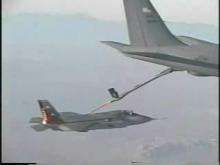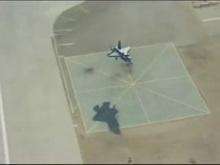Rolls-Royce LiftSystem
| LiftSystem | |
|---|---|
 | |
| The Rolls-Royce LiftSystem coupled to an F135 turbofan at the Paris Air Show in 2007 | |
| Type | STOVL Lift system |
| Manufacturer | Rolls-Royce plc |
| Major applications | F-35 Lightning II |
|
| |
The Rolls-Royce LiftSystem, together with the F-135 engine, is an aircraft propulsion system designed for use in the STOVL variant of the F-35 Lightning II. The complete system, known as the Integrated Lift Fan Propulsion System (ILFPS), was awarded the Collier Trophy in 2001.[1]
Requirement
The F-35B STOVL variant of the Joint Strike Fighter (JSF) aircraft is intended to replace the vertical flight Harrier, which was the world's first operational short-takeoff / vertical-landing fighter. A requirement of the JSF is that it can attain supersonic flight, and a suitable vertical lift system that would not compromise this capability was needed for the STOVL variant. The solution came in the form of the Rolls-Royce LiftSystem, developed through a $1.3 billion System Development and Demonstration (SDD) contract from Pratt & Whitney.[2] This requirement was met on 20 July 2001.[3][4]
Design and development
Instead of using lift engines or rotating nozzles on the engine fan like the Harrier, the "LiftSystem" has a shaft-driven LiftFan, designed by Lockheed Martin and developed by Rolls-Royce,[2] and a thrust vectoring nozzle for the engine exhaust that provides lift and can also withstand the use of afterburners in conventional flight to achieve supersonic speeds.[3] The system has more similarities to the Russian Yakovlev Yak-141 and German EWR VJ 101D/E than the preceding generation of STOVL designs to which the Harrier belongs.[5]
The team responsible for developing the propulsion system includes Lockheed Martin, Northrop Grumman, BAE Systems, Pratt & Whitney and Rolls-Royce, under the leadership of the United States Department of Defense Joint Strike Fighter Program Office. Paul Bevilaqua,[6] Chief Engineer of Lockheed Martin Advanced Development Projects (Skunk Works), invented the lift fan propulsion system.[7] The concept of a shaft-driven lift-fan dates back to the mid-1950s.[8] The lift fan was demonstrated by the Allison Engine Company in 1995-97.[9]
The U.S. Department of Defense (DOD) awarded General Electric and Rolls-Royce a $2.1 billion contract to jointly develop the F136 engine as an alternative to the F-135. The LiftSystem was designed to be used with either engine.[2] Following termination of government funding GE and Rolls-Royce terminated further development of the engine in 2011.[10]
Rolls-Royce is managing the overall development and integration programme from its site in Bristol, UK, which is also responsible for the LiftFan turbomachinery, 3BSM and Roll Post designs. The team in Indianapolis, US, will provide the system’s gearbox, clutch, driveshaft and nozzle and will conduct the build and verification testing of the LiftFan.
Operation
The Rolls-Royce LiftSystem comprises four major components:[2]
- LiftFan
- Engine to fan driveshaft [11]
- Three-bearing swivel module (3BSM)
- Roll posts (two)
The three-bearing swivel module (3BSM) is a thrust vectoring nozzle at the tail of the aircraft which allows the main turbofan cruise engine exhaust to pass either straight through with reheat capability for forward propulsion in conventional flight, or to be deflected downward to provide aft vertical lift.[12]
In "lift" mode for assisted vertical maneuvers, 29,000 hp[13][14][15] is diverted forward through a driveshaft from the engine's low-pressure (LP) turbine via a clutch[16] and bevel-gearbox to a vertically mounted, contra-rotating lift fan located forward of the main engine. The fan efflux (low-velocity unheated air) discharges through a thrust vectoring nozzle on the underside of the aircraft, thus balancing the aft lift generated by the 3BSM. For lateral stability and roll control, bypass air from the engine goes out through a roll-post nozzle in each wing.[17] For pitch control, the areas of exhaust nozzle and LiftFan inlet are varied conversely to change the balance between them while maintaining their sum, and with constant turbine speed. Yaw control is achieved by yawing the 3BSM.[15] Forward, and even backward, motion is controlled by tilting the 3BSM and LiftFan outlet.[4]
The following indicates the component thrust values of the system in lift mode:[2]
| 3BSM (dry thrust) | LiftFan | Roll posts (combined) | Total |
|---|---|---|---|
| 18,000 lbf (80 kN) | 20,000 lbf (89 kN) | 3,900 lbf (17 kN) | 41,900 lbf (186 kN) |
In comparison, the maximum thrust of the Rolls-Royce Pegasus 11-61/F402-RR-408, the most powerful version which is used in the AV-8B, is 23,800 pounds-force (106 kN).[18] The weight of the AV-8B is about 46% of the weight of the F-35B.
Like lift engines, the added LiftSystem components are dead weight during flight, but the advantage of employing the LiftSystem is that its greater lift thrust increases takeoff payload by an even larger amount. Also, the fan's cool efflux reduces the harmful effects of hot, high-velocity air which can harm runway pavement or an aircraft carrier deck.
Engineering challenges
While developing the LiftSystem many engineering difficulties had to be overcome, and new technologies exploited.[19]
The LiftFan utilises hollow-bladed titanium blisks (a bladed disk or "blisk" achieved by super-plastic forming of the blades and linear friction welding to the blisk hub).[20] Organic matrix composites are used for the interstage vanes. The LiftFan must safely function[21] at flight speeds up to 250 knots (130 m/s) This condition appears as a crosswind to the horizontal intake and occurs when the aircraft transitions between forward flight and hover.[22]
The clutch mechanism uses dry plate carbon–carbon technology originally derived from aircraft brakes. Friction is only used to engage the lift fan at low engine speeds. A mechanical lock-up is engaged before increasing to full power.[23]
The gearbox has to be able to operate with interruptions to its oil supply of up to a minute while transferring full power through 90 degrees to the LiftFan.
The Three-Bearing Swivel Module has to both support the final hot thrust vectoring nozzle and transmit its thrust loads back to the engine mounts. The "fueldraulic" actuators for the 3BSM use fuel pressurised to 3,500 lbf/in2, rather than hydraulic fluid, to reduce weight and complexity. One actuator travels with the swivel nozzle, moving through 95 degrees while subject to intense heat and vibration.
Testing
During concept definition of the Joint Strike Fighter, two Lockheed airframes were flight-tested: the Lockheed X-35A (which was later converted into the X-35B), and the larger-winged X-35C,[24] with the STOVL variant incorporating the Rolls-Royce LiftFan module.
LiftSystem flight testing commenced in June 2001, and on 20 July that year the X-35B became the first aircraft in history to perform a short takeoff, a level supersonic dash and vertical landing in a single flight. By the time testing had been completed in August, the aircraft had achieved 17 vertical takeoffs, 14 short takeoffs, 27 vertical landings and five supersonic flights.[3] During the final qualifying Joint Strike Fighter flight trials, the X-35B took off in less than 500 feet (150 m), transitioned to supersonic flight, then landed vertically.[25]
Ground tests of the F136/LiftSystem combination were carried out at the General Electric facility in Peebles, Ohio in July 2008. On 18 March 2010, a STOVL equipped F-35B performed a vertical hover and landing demonstration at Patuxent River Naval Air Station in Lexington Park, MD.[26]
Collier Trophy award
In 2001, the LiftSystem propulsion system was awarded the prestigious Collier Trophy,[27] in recognition of "the greatest achievement in aeronautics or astronautics in America", specifically for "improving the performance, efficiency and safety of air or space vehicles, the value of which has been thoroughly demonstrated by actual use during the preceding year."[3]
Specifications (LiftSystem)
- Main engine
- Pratt & Whitney F135
- 17,600 pounds-force (78 kN) dry thrust
Components:[2]
- LiftFan
- Two-stage contra-rotating hollow titanium blisk fan of 50 inches (1.3 m) diameter. Uppermost fan fitted with variable inlet guide vanes. Capable of generating more than 20,000 pounds-force (89 kN) cold thrust[20]
- Three-bearing swivel module
- Able to rotate through 95 degrees in 2.5 seconds and vector 18,000 pounds-force (80 kN) dry thrust in lift mode, with reheat capability in normal horizontal attitude
- Roll posts
- Two: hydraulically actuated
Gallery
-
X-35/LiftSystem flight demonstration of transition to VTOL configuration, hover, take off in STOVL configuration, in-flight re-fuelling, vertical hover and landing.
-
Vertical landing demonstration showing operation of the 3BSM.
-
Turbine and lift fan assembly on display at the National Air and Space Museum, Steven F. Udvar-Hazy Center
See also
- Related lists
References
- ↑ "http://naa.aero/userfiles/files/documents/Press%20Releases/Collier%202001%20PR.pdf
- 1 2 3 4 5 6 LiftSystem Rolls-Royce website. Retrieved: December 2009
- 1 2 3 4 Propulsion System in Lockheed Martin Joint Strike Fighter wins Collier Trophy. Lockheed Martin press release, 28 February 2003. Retrieved: 3 November 2008
- 1 2 From Supersonic to Hover: How the F-35 Flies By Chris Kjelgaard Senior Edito posted: 21 December 2007
- ↑ https://books.google.fi/books?id=49QmlNcqlUAC&pg=PA86&lpg=PA86&dq=The+STOVL+version+of+both+power+plants+use&source=bl&ots=IoybiGjMZl&sig=QP4kz9J1iA0TWRSNN5vxCXJoOGQ&hl=fi&sa=X&ei=K-I0VdXMB4WNsAG2zYPQBg&ved=0CB4Q6AEwAA#v=onepage&q=The%20STOVL%20version%20of%20both%20power%20plants%20use&f=false
- ↑ Undated Lockheed Martin video. Retrieved December 2009
- ↑ "Propulsion system for a vertical and short takeoff and landing aircraft", United States Patent 5209428
- ↑ Rolls-Royce LiftSystem (United States), AERO-ENGINES - LIFTFAN Jane's Aero-Engines. Retrieved: 4 November 2008
- ↑ "-as Allison begins JSF lift-fan tests" Flight International, 21 May 1997. Retrieved: 19 September 2010. Archived on 2 November 2012.
- ↑ Norris, Guy. "GE, Rolls Give Up on F136 JSF Alternate Engine." Aviation Week, 2 December 2011.
- ↑ Warwick, Graham. "F-35B - Driveshaft" Aviation Week & Space Technology, December 09, 2011. Accessed: April 10, 2014.
- ↑ Warwick, Graham. "F-35B - Swivel Nozzle" Aviation Week & Space Technology, December 09, 2011. Accessed: April 10, 2014.
- ↑ Warwick, Graham. "F-35B - The STOVL Challenges" Aviation Week & Space Technology, December 09, 2011. Accessed: April 10, 2014.
- ↑ Warwick, Graham. "F-35B - Lift Fan" Aviation Week & Space Technology, December 09, 2011. Accessed: April 10, 2014.
- 1 2 Lockheed Propulsion System VTOL.org. Retrieved: 19 September 2010.
- ↑ Warwick, Graham. "F-35B - Clutch" Aviation Week & Space Technology, December 09, 2011. Accessed: April 10, 2014.
- ↑ Warwick, Graham. "F-35B - Roll posts" Aviation Week & Space Technology, December 09, 2011. Accessed: April 10, 2014.
- ↑ STOVL pedigree gives Rolls-Royce key technology edge. Rolls-Royce: Defence Aerospace. Retrieved: 5 November 2008
- ↑ Going vertical – developing a short take-off, vertical landing system. Ingenia Online (PDF) August 2004. Retrieved: December 2009. Raw text: http://www.ingenia.org.uk/ingenia/articles.aspx?Index=271
- 1 2 "Rolls-Royce's LiftSystem for the Joint Strike Fighter" By Ellie Zolfagharifard, The Engineer 28 March 2011
- ↑ Warwick, Graham. "F-35B - Doors 1 Doors 2" Aviation Week & Space Technology, December 09, 2011. Accessed: April 10, 2014.
- ↑ Zolfagharifard, Ellie. "Rolls-Royce's LiftSystem for the Joint Strike Fighter" The Engineer (magazine), 28 March 2011. Archived on 19 December 2013]
- ↑ "The Shaft Driven Lift Fan Propulsion System for the Joint Strike Fighter" P. Bevilaqua, Presented at the American Helicopter Society 53rd annual forum, Virginia Beach, Virginia, April 29-May 1, 1997
- ↑ Joint Strike Fighter official site - History page
- ↑ PBS: Nova transcript "X-planes"
- ↑ Lockheed Martin press release Retrieved: 18 March 2010
- ↑ Collier 2000–2007 Winners National Aeronautic Association. Retrieved: 10 November 2008
External links
| Wikimedia Commons has media related to Rolls-Royce LiftSystem. |
- Pratt & Whitney F135 - Project milestones
- Rolls-Royce - LiftSystem
- GovExec: The engine that could
- The man with the fan
- Paul M. Bevilaqua : The shaft driven Lift Fan propulsion system for the Joint Strike Fighter DTIC.MIL Word document, 5.5 MB. Date: 1997.
- Two approaches to achieving short takeoff and vertical landing Design Engineer - Aerospace, 21 February 2013
- F-35B Lightning II Three-Bearing Swivel Nozzle Code One Magazine, 12 August 2014
| ||||||||||||||||||||||
| |||||||||||||||||||||||||||||||||


